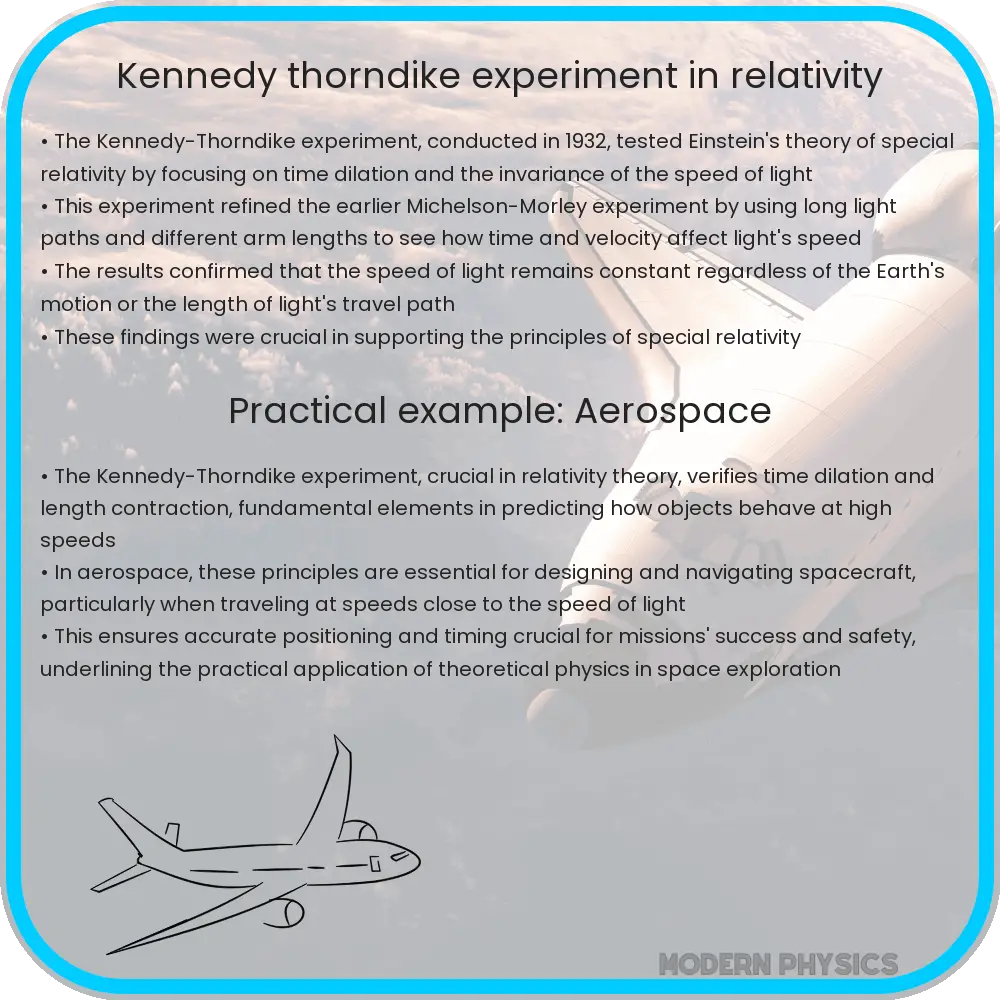Explore the Kennedy-Thorndike Experiment’s role in confirming Einstein’s relativity, its impact on physics, and its legacy in modern science.

Understanding the Kennedy-Thorndike Experiment: A Milestone in Modern Physics
The Kennedy-Thorndike Experiment, conducted in 1932 by Roy J. Kennedy and Edward M. Thorndike, is a pivotal study in the field of physics, specifically in understanding the principles of time dilation and the theory of relativity. This experiment was designed to test the Lorentz contraction hypothesis, a fundamental aspect of Albert Einstein’s Special Theory of Relativity. By delving into this experiment, we can better comprehend how it contributed to our understanding of the fabric of space and time.
The Fundamentals of the Kennedy-Thorndike Experiment
At its core, the Kennedy-Thorndike Experiment aimed to explore the effects of Earth’s motion through space on the speed of light. The experiment was an extension and modification of the famous Michelson-Morley experiment, which had previously attempted to detect the ether wind – the hypothetical medium thought necessary for the propagation of light waves. Kennedy and Thorndike’s approach differed in that they varied the length of the optical paths, as opposed to the Michelson-Morley experiment which had equal arm lengths in its interferometer.
The experiment utilized an optical resonator, with the crucial modification that one arm was made longer than the other. This setup was expected to detect any differences in the speed of light due to the motion of the Earth through space. The logic was simple: if the speed of light was constant and independent of the motion of its source, then there should be no observable change in the interference patterns of light beams as the Earth moved in different directions through space.
Time Dilation and the Theory of Relativity
The Kennedy-Thorndike Experiment’s results had profound implications for the concept of time dilation, a critical component of Einstein’s theory of relativity. Time dilation refers to the phenomenon where time is observed to run slower when an object is moving at high speeds relative to a stationary observer. This concept challenged the classical notion of absolute time and space, suggesting that time could vary depending on the relative motion of observers.
Through their meticulous experimental setup, Kennedy and Thorndike demonstrated that the speed of light remained constant regardless of the Earth’s motion or the length of the optical paths in the interferometer. This outcome was a compelling confirmation of the Special Theory of Relativity, which posits that the laws of physics are the same in all inertial frames and that the speed of light in a vacuum is constant for all observers, regardless of their relative motion.
The experiment underscored the revolutionary idea that measurements of time and space are not absolute but are relative to the observer’s state of motion. This insight laid the groundwork for further exploration into the bizarre and fascinating world of relativistic physics, fundamentally altering our understanding of the universe.
Implications of the Kennedy-Thorndike Experiment
The Kennedy-Thorndike Experiment not only validated the Special Theory of Relativity but also paved the way for further scientific inquiry into the nature of space and time. One of the most significant implications of their findings is the understanding that measurements of time and space are relative to the observer. This realization has had far-reaching effects, influencing everything from GPS satellite technology, which must account for time dilation effects, to our understanding of cosmic phenomena.
The constancy of the speed of light, as confirmed by this experiment, is a cornerstone of modern physics. It suggests that no matter the relative motion between the source of light and the observer, light’s speed remains unchanged. This principle has profound implications for our understanding of the universe, influencing the development of technologies and scientific theories that rely on this fundamental constant.
Legacy and Continuing Relevance
Decades after the Kennedy-Thorndike Experiment, its findings continue to influence modern physics. The experiment’s methodology and results are often revisited in advanced studies of optical physics and relativity. It stands as a testament to the power of experimental physics in validating and refining theoretical models.
Moreover, the experiment’s success in demonstrating the relativistic nature of time and space has been crucial in advancing our understanding of the universe. It has led to the development of more complex theories, such as General Relativity, which extends the principles of Special Relativity to include gravity and accelerated frames of reference.
Conclusion
In conclusion, the Kennedy-Thorndike Experiment was a landmark in the history of physics. Its successful challenge to the classical notions of time and space provided crucial empirical support for Einstein’s Special Theory of Relativity. By confirming that the speed of light is constant and that time and space measurements are relative, it ushered in a new era of scientific understanding. The experiment’s legacy continues to resonate in various fields of science and technology, influencing the way we perceive and interact with the world around us. The innovative spirit and rigorous methodology demonstrated by Kennedy and Thorndike remain inspirational for scientists and enthusiasts alike, underlining the importance of empirical validation in the advancement of theoretical physics.
Is this conversation helpful so far?
